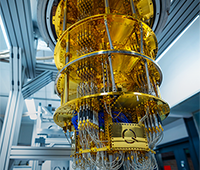Sun Moving to Underscore New Strategy
Sun Microsystems opened its JavaOne software conference in San Francisco by announcing several partnerships intended to strengthen the company’s position in the rapidly growing mobile Internet business. This year’s event will also underscore Sun’s shift to a lower-cost, industry standard chip strategy for corporate server markets.
Sun’s Java language competes with Microsoft’s Visual Studio as systems that programmers use to design software. At this year’s event, which will be held through Thursday, Sun will introduce a new software system, called Java Creator, that is intended to simplify the task of writing software applications.
Sun will announce new partnerships with both Orange and Vodafone, the two largest European cellphone companies, to develop new Java-based applications for cellphone handsets. The wireless phone market is one where Sun has a clear lead over Microsoft, whose efforts have been resisted both by handset manufacturers and by cellular network operators. Both industries have been concerned about the dominance of Microsoft’s Windows operating system in the personal computer industry.
The company, in showing that its Java software strategy is propelling the computer maker into new markets, is expected to announce that there are now four million Java software developers and that the programming language has become a standard tool in cellular phone, automotive and other consumer electronics markets.
The company’s new president, Jonathan Schwartz, is also leading Sun to rely less on its proprietary Sparc microprocessor chip and more on systems based on Advanced Micro Device’s 64-bit Opteron microprocessor, which has shown surprising strength in business and Internet applications.
Sun is the last major computer maker to recover from the technology industry recession, having had big losses and layoffs in both 2001 and 2002. Some industry analysts have dismissed any chance of recovery for Sun, arguing that the company is increasingly squeezed between Microsoft’s Windows monopoly and the open-source world of the Linux operating system.
Sun, based in Santa Clara, Calif., has been searching for a middle ground and is betting that it will be able to gain market share in the transition from 32-bit to 64-bit systems in business computing markets.
Last quarter, Sun disappointed analysts and its stock has fallen, closing Friday at $4.41, down from a high of $5.93 in January. However, several people with knowledge of the company’s business said that two factors – surprising demand for its low-cost A.M.D.-based servers and the first signs that the telecommunications industry is beginning to recover – could help the computer maker significantly in its fourth quarter, which ends Wednesday.
In an interview this week at Sun’s research and development campus in Menlo Park, Calif., Mr. Schwartz said the company was determined to compete effectively in the high-volume, low-cost server market that is dominated by computers based on microprocessors sold by Intel and A.M.D.
“The keys to the kingdom in the developer world are based on volume,” Mr. Schwartz said. “We’re acutely sensitive to the volume question.”
Sun’s effort in the standard server world is expected to pick up steam later this year when it introduces the first A.M.D.-based products designed by Andreas Bechtolsheim, a co-founder of the company. Mr. Bechtolsheim returned to Sun earlier this year when the computer maker acquired his start-up company, Kealia Inc.
Along with three partners, Mr. Bechtolsheim created Sun in the early 1980’s by introducing a low-cost workstation computer based on standard industry parts.
The Opteron strategy is widely believed to be Sun’s best opportunity to pull out of its troubles, even though the company is only now starting to sell significant numbers of the systems.
“This is the first quarter that Sun has any volume,” said Mark Stahlman, a computer industry at Caris & Company, an investment bank based in New York. Demand for the servers has outstripped the company’s supply, he said.
Sun is expected to announce on Monday that it is contributing a portion of its Java Desktop System, the company’s version of the Linux operating system, to the open-source community. The software technology, called Project Looking Glass and Java 3d, makes it possible to develop images that have more depth than conventional images on computer displays.
Mr. Schwartz will also announce that he plans to begin writing his own Web log on a regular basis. Several Sun employees maintain online dairies, known as blogs, at both official and unofficial Web sites. Mr. Schwartz said he was interested in reaching a computer industry audience directly, unfiltered by reporters.



